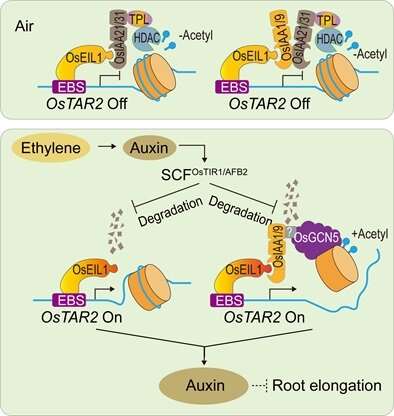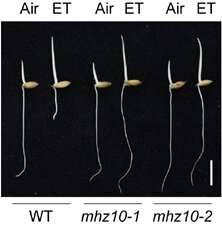Researchers uncover new crosstalk between phytohormones ethylene and auxin

Researchers led by Prof. Zhang Jinsong from the Institute of Genetics and Developmental Biology (IGDB) of the Chinese Academy of Sciences (CAS), devoted to the studies of ethylene signaling pathway and its regulation in rice, have recently disclosed a new crosstalk between the phytohormones ethylene and auxin at a previously underappreciated level. Results were published in The Plant Cell on August 16.
Ethylene plays important roles in the environmental adaptation of plants. Auxin is essential for plant development. For more than three decades, the ethylene signaling pathway has been extensively studied using the phenotypic change in "triple response" of Arabidopsis. Rice is a semi-aquatic monocot, the ethylene responses of its young seedlings normally show the so-called "double response," namely promoting the coleoptile/mesocotyl elongation whereas inhibiting the root elongation.
In recent years, through analysis of a series of mao hu zi (mhz) mutants, Prof. Zhang's lab has identified the ethylene signaling pathway in rice. The major components of this pathway are very similar to those in Arabidopsis. However, his team also discovered new regulators and an additional branch signaling pathway in rice. Besides, other phytohormones, such as the abscisic acid, Jasmonic Acid and auxin, were found to participate in rice ethylene response.
In this study, they further found that mutation of the MAO HU ZI10/tryptophan aminotransferase-related (MHZ10/OsTAR2) gene in auxin biosynthesis pathway renders rice roots unresponsive to ethylene.

Genetic and molecular analyses proved that the transcription regulator OsEIL1 in ethylene signaling pathway directly upregulates MHZ10/OsTAR2 expression in root ethylene response.
The researchers did not ignore an unusual phenomenon that no ethylene response of MHZ10/OsTAR2 expression in the mhz10 mutants. Focusing on this point, they uncovered positive feedback of auxin to ethylene at the signaling level.
In this feedback regulation, the OsIAA1/9 and OsIAA21/31 in auxin signaling pathway interact with OsEIL1, and show surprisingly promotive activity and unexpected repressive activity to OsEIL1 through mediating the acetylation or deacetylation of histone, respectively. It may help rice root to respond to environmental stresses quickly.
This study provides a deeper understanding of the interaction between ethylene and auxin in rice, and it will facilitate the optimization of root growth in rice variety in response to various environmental changes.
More information: Yang Zhou et al, Rice EIL1 interacts with OsIAAs to regulate auxin biosynthesis mediated by the tryptophan aminotransferase MHZ10/OsTAR2 during root ethylene responses, The Plant Cell (2022). DOI: 10.1093/plcell/koac250
Journal information: Plant Cell
Provided by Chinese Academy of Sciences


















